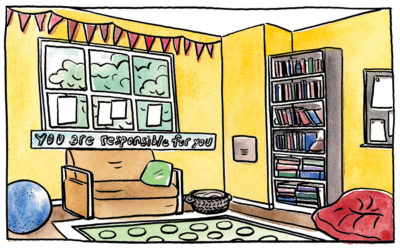This year I made the transition from teaching at a school with various high-needs populations, to a school with considerably lower Free and Reduced-Lunch numbers. The schools couldn’t feel less alike, and one of the greatest factors in this difference lies in the counseling offices. If we are serious about combating the opportunity gap, we need more counselors where it is needed most. It looks like Superintendent Reykdahl gets this, to some degree – he supported ESHB 2224, which passed, and will provide more funding for school counselors at the middle school level (mainly to comply with High School and Beyond Plan development for students).
I would wager that any teacher anywhere would support increases in school counseling positions (caveat: unless it means we have to give up another vital support for students). The top-priority goal of the 2013-18 strategic plan of the WA State Counseling Association is to “Pass legislation that establishes and funds lower ratios for ALL levels (elementary, middle & high school).”
As Seattle becomes less and less live-able for so many lower-income city residents, the allocation of counseling services amongst schools is especially critical, and needs to be redesigned.

My current middle school has almost 900 students and 3 full-time counselors – one for each house/grade (6th-8th grades). My old elementary school has a highly fluctuating number of students – more on that in a bit – which generally totals around 250-300 students (grades PreK-5th), and a half-time counselor. Looking strictly at enrollment numbers, this seems fair: the more students at a school, the more counselor FTE (percentage of full-time position), a school gets.
But not all students have equal need for a counselor. School counselors serve students in a number of capacities. Historically, they started as vocational advisors. ”The role of school counselors continued to develop in parallel to changes in education and society. As the momentous social issues of the 1960s arose, the field focused increasingly on the developmental, personal, and social issues of students and on cultural sensitivity. In the late 1960s and the 1970s, the work of counselors became more entwined with central school goals for student academic success (Gladding, 2012).”
Doesn’t it make sense to base the number of counselors (and percentage of full-time work), based on the school population’s individual needs, rather than enrollment numbers alone?
This is sort-of already happening at Seattle Public Schools. According to this year’s Weighted Staffing Standards, an elementary school receives a half-time position for EITHER a counselor, a social worker, or a head teacher IF it qualifies as “Focus or Priority (the school is not doing well by various metrics); has Greater than 50% poverty per OSPI; or has a Social/Emotional Behavior program.” Excellent! But don’t make us choose!
![]()
![]()
![]()
![]()

At my old school, the half-time counselor tried to the best of their well-qualified ability to meet students’ needs. But the school included all downtown housing shelters, and the school population includes a huge, and growing number of students whose lives are in major turmoil and transition. Students regularly show up at the main office with no records of any evaluations for special ed services required, and no information about their academic and behavioral needs (which are often plentiful, due to the trauma they were/are experiencing). They stay for a month, a quarter, sometimes more. Special funding pays for a Family Support Worker, who does incredible, on-the-ground work to coordinate families with various resources. But we chose the half-time counselor position over the Head Teacher position, which was very much needed, too. KUOW recently profiled the school, and brought up the need for more staff development around trauma-informed instructional practices. But when you have a number of students who didn’t sleep the night before because of noise in the shelter; who are not yet evaluated for special services, who are shutting down or starting conflicts; who don’t yet feel safe and trusting of the classroom…no amount of professional development will be enough. You need more trained professionals in a building to meet needs, particularly counselors.
At my new school, we have monthly house meetings, led by our counselors, to examine the academic, social/emotional, and physical needs of each student in the school. Students of concern are discussed by all of us, and we look for gaps in how we are serving them. Recently, one of my 6th graders shared with me that he hadn’t slept the night before. This happened again, and again. I started checking in with him a little more frequently; he was on my mind more than others. When he told me that he hadn’t slept for the three prior nights, had been walking around, and that his mom didn’t know, my concern grew. Was this enough to warrant a report of potential neglect?
I went to the 6th grade counselor for advice and help. She was on it immediately because she was available – she wasn’t stretched between hundreds of kids with similar concerns. She met with the student the next day, learned a lot more about his life, and determined that his home is stable and loving. We got some additional supports in place for him: a schedule change to include a study-skills class, some regular appointments with the counseling office. His vocational future is inseparable from his current well-being and his on-going academic success. Having counseling services to support him in all of this is invaluable.
I hope that the particular needs of students at a school shapes the way we fund counseling positions; it’s an issue of equity and teachers, alone, can’t meet the social-emotional needs of students.
Robyn, thanks for bringing this important issue to light. Our small rural district has one counselor, K-12, for over 500 students. He WAS primarily a guidance counselor, but our rate of poverty, homelessness, and other disruptive issues has increased dramatically in the last decade. The poor guy is overwhelmed with kids needing his help these days. Our need is HIGH. A local mental health agency sends a counselor out to support us weekly, and, as always, teachers step in to talk to troubled kids, and our principal is constantly counseling. How do we get what we actually need?
My building is incredibly lucky to be served by an amazing counselor. It is no hyperbole to say that she has saved hundreds of lives.